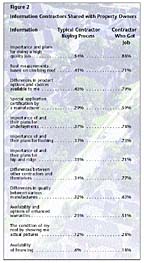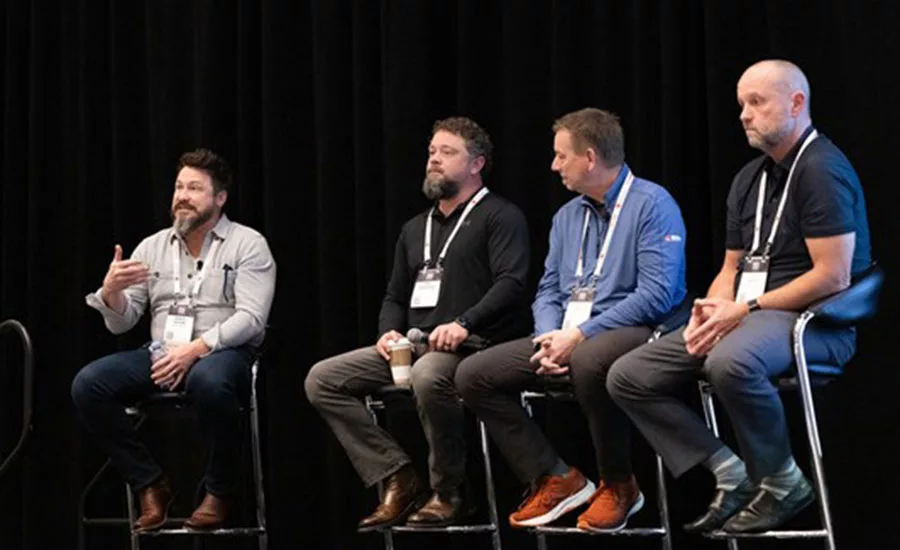Survey of Homeowners Demonstrates How Contractors Can Build Their Business
Have you ever felt like you were drowning in information about how to market your roofing contracting business to homeowners but felt starved for knowledge on what, why and how consumers really made their purchasing decisions?
As an industry, it is critical that we continue to build a better understanding of the ultimate consumer. Historically, too many property owners have viewed our industry as a commodity, meaning they perceive that there are no differences in quality of services provided and therefore make their decisions only related to the price. When this occurs, it hurts all involved. When price is the primary decision driver, owners often receives an inferior roof system and are not even aware of the options that can potentially enhance the value of their home. Contractors often receive inadequate profits relative to their investment of time, assets and the liability they are accepting for so many years out into the future.
The more the industry understands what, why and how the consumer makes purchasing decisions beyond price, the more capable the industry is of continuing progress, evolving forward and away from a commodity-driven marketplace.
With comprehensive support from Roofing Contractor magazine and in conjunction with The Jerry Lean Show (on WOR – 710 AM Radio in New York, one of the largest stations broadcasting a home improvement show in America), a survey was sent to more than 1,500 homeowners across the United States. The homeowners have purchased asphalt shingle roofs within the last 18 months. Special thanks to GAF Materials Corp., Elk Corp. and CertainTeed Corp. for their support in helping to obtain this nationally representative sample of consumers.
Overall, Good News
Homeowners surveyed are satisfied with the results of their roofing contractor decisions. Specifically, 96 percent said they received a good value for the money they invested. Further, 92 percent said that they would recommend the contractor they used to others. As expected, the primary reason for not recommending a contractor was workmanship; the second most important reason was poor clean up.Why Homeowners Called Professional Roofers
Isn’t the perception by many in the industry that homeowners buy replacement roofs when they leak? The survey suggests that this perception is inaccurate. Two thirds of homeowners wanted a roof estimate simply because their roof was getting old. Only 26 percent of homeowners replaced their roof because they had a leak. In fact almost an equal amount (23 percent), replaced their roof simply because they didn’t like the appearance. About 20 percent of homeowners replaced their roof due to storm or hail damage.
Where is the opportunity for contractors based on this data? Consider sharing with homeowners on the same and adjacent streets to your current projects that their roof is around the same old age and has the same tired appearance of the one you are now replacing. If they are considering a roof replacement, they can check references from their neighbor (your customer) about the high-quality job you have done. As an example, there are tools available from a variety of sources to make this easy, such as GAF SmartMail™, which is a customized postcard that can be mailed on a “turn-key” basis to the 100 closest homeowners of your existing client for an investment of under $60.
Where Do Homeowners Find Their Contractor?
Friends and yellow pages each received 19 percent of the mentions for sources of contractors, and neighbors got 17 percent, for a combined 55 percent of the total of sources from which homeowners found contractors to provide bids for their properties. (See Figure 1.) Interestingly, the majority of sources for homeowners are from forms of referrals based on relationships the contractor already has as opposed to “paid for” leads directly reaching the property owner.What is the implication for contractors? How much of your yellow page investment is actually being used by homeowners “looking up” your phone number based on referrals by neighbors and friends as opposed to responses specifically from viewing your advertisement? Does your ad need to be as big? What else might you consider to increase the likelihood that a friend or neighbor of a prospect will refer you?
I also think it’s interesting that the combination of lawn and truck signs generates almost 60 percent of the effectiveness of yellow pages (11 percent vs. 19 percent of mentions), given that signage is a fraction of yellow page cost. Ask yourself: “Is there an opportunity to invest more effectively and efficiently in signage to increase exposure?”
Figure 1
Sources of Contractors (% of Mentions)
Raw data for table: %
friend 19
yellow pages 19
neighbor 17
lawn sign 8
newspaper 6
relatives 6
direct mail 3
Internet 3
truck sign 3
previous use 2
insurance 2
contractor 1
solicitor 1
TV 1
Do Homeowners Take the Lowest Price? No!
Typically, single-family homeowners report that there is a wide difference in bids they receive. On average, homeowners were successful in actually receiving three bids. The bid they accepted was typically more than 15 percent higher than the lowest price quote. The most common single family quotes were: high, $7,750; low, $5,100; and actual paid, $5,950. Note: most common (median) homes were 2,000 square feet.
What are Contractors Communicating? What are Homeowners Buying?
Homeowners were asked what information the typical contractor shared with them during the buying process. I then compared this to what information homeowners said the contractor who got the job shared. (See Figure 2.)
What is my conclusion from the data? The better you educate the property owner about your products and services, the more likely they will buy from you. Simply completing a proposal with a price and dropping it off or sending it in the mail at best gets you the worst customers because it is likely that their decision was based on the lowest price. At worst, it is a waste of time because you’re less likely to get the project.
Increase Your Odds of Winning
Based on this research, how can you increase the odds of winning projects at better prices and margins? First, educate the property owner on your plans for doing a quality job and where and how your processes are different from other contractors. Typically, only 54 percent of contractors discussed the importance of doing a high-quality job, while 88 percent of the contractors that actually won the project discussed this. Further, only 34 percent of contractors attempted to describe differences between themselves and other contractors; however, the contractors that earned the project discussed their differences with 77 percent of their homeowners during the buying process, suggesting that this is very important to earning the business. Share some details about your step-by-step procedures. What is the pre-job preparation? What are the major steps in your project management approach to prevent problems before they happen? When the project is completed, what are the quality-assurance action steps? Share a process flow diagram — and demonstrate your professionalism.Second, provide product options. Only 45 percent of typical contractors offer options, while 79 percent of the contractors that won the project discussed option differences with the property owner during the buying process. Discuss the details of the roofing system. Discuss the flashing. Discuss the underlayment. Discuss the shingle options. Discuss the hip and ridge. Its clear from the data that the customer that learns about the system details from you is more likely to buy from you.
My experience is that a “good, better, best” option presentation of shingles always improves your mix of product that the customer buys over time. Why? It lends itself to a good discussion process where the customer feels you are helping rather than selling and focusing on what’s in it for them rather than what’s in it for you. Further, there are people that always want the best; there are people that always want the cheapest; however, most people never want the cheapest. Presenting “good, better, best” keeps you from trying to guess what they want. Without a “good, better, best” approach, salespeople tend to assume they’re competing on price and mistakenly bid the lower-priced products.
Third, provide the unexpected. Manufacturer certification, providing special manufacturer warranty upgrades, financing and showing pictures of your customers’ roof are all examples of great opportunities. Strategic competitive advantage is doing what is proven important — but also other contractors aren’t doing or saying. It makes you more special. It builds value. As a result, it improves your sales growth and profitability. The data provides four examples of opportunities for competitive advantage.
Manufacturers and Certification. Only 29 percent of contractors discuss manufacturer certification. However, the contractors that actually got the job discussed their certification status 59 percent of the time! Furthermore, only 32 percent of contractors discussed differences in manufacturers; however, 63 percent of the contractors that won the business discussed the differences in the manufacturers they used vs. the quality of other products.
Enhanced Warranties. Only 25 percent of contractors discussed enhanced warranties. However, 51 percent of the contractors that won the business discussed enhanced warranties. When you consider that enhanced warranties have only existed in the steep- slope industry for about five years when GAF first introduced the concept, it suggests that there is tremendous opportunity for the professional contractor to demonstrate value and differentiate themselves to homeowners.
Financing. Only 6 percent of contractors mention financing. However, it is discussed by 18 percent of the contractors from whom the homeowner actually purchased a roof. What does that mean? Financing isn’t necessarily something the homeowner needs — but it clearly adds credibility! And credibility helps gain more sales.
Climb, Measure and Photograph. Only 41 percent of contractors climbed to measure the roof; 71 percent of the roofing contractors that won the job climbed. While you are doing your visual inspection, why not take a few photos of the damage you find and show it to the homeowner when you come down? Only 12 percent of contractors do this now, and only 28 percent of the contractors that won the project did. Want to really “wow” them? Show a picture of what their home will look like with different shingle styles and colors using available industry software such as GAF SmartSolutions™.
Summary Thoughts
The overall results of this consumer research are encouraging. Homeowners are satisfied with their decisions. They believe they are getting a good value. Despite industry perception, the homeowner is typically not choosing the lowest price. That is especially true when the contractor clearly explains their evaluation of the homeowner’s roof, the roof system product and warranty options available, and the step-by-step installation, quality assurance and clean-up process.The results also provide insight into how contractors can improve their effectiveness with the property owner even more. Helping the homeowner understand differences in products, systems, services, processes and warranties makes a difference and builds value. This data also proves that this industry is only a commodity market if the contractor wants it to be a commodity. When the contractor educates the homeowner, the roofing industry is not a commodity market and has a lot more potential for an even brighter future. That encourages me and reminds me again why I’m one of those romantics that actually love this industry, because it is one of those few businesses where you can come to work everyday, and make a difference and actually help people.
So do you part! As Bear Bryant said, “Cause something to happen.”
Looking for a reprint of this article?
From high-res PDFs to custom plaques, order your copy today!






